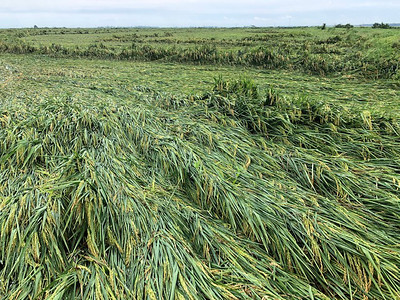Tropical Depression 9 looms as Arkansas farmers begin harvest
A year after the remnants of Laura battered Arkansas, TD9 is looming in the Caribbean with the potential to affect the state as harvest begins.
By Mary Hightower
U of A System Division of Agriculture
Fast facts
- Tropical event can cause damage with winds, water
- Arkansas’ rice, corn harvest at beginning stages
(300 words)
(Newsrooms — SUBS lede to add dropped word attention; SUBS grafs 2-3 to CORRECT time element from Friday to Thursday; 9th graf to add dropped word get
We have file art from last year’s tropical system Laura here: https://flic.kr/s/aHsmQoxq3U)
LITTLE ROCK — Arkansas growers will be paying closer attention to their weather apps with development of Tropical Depression 9 and a forecast path that could bring the storm’s wind and rain to the delta by early next week.
TD9 was churning in the Caribbean southwest of Jamaica on Thursday making its appearance a year after the remnants of Hurricane Laura battered crops in Arkansas and elsewhere in the Mid-South. (See: https://bit.ly/3Didpvc). The National Hurricane Center’s “cone” forecast showed the storm was expected to gain hurricane strength as Ida by Saturday morning, make landfall in Louisiana between Sunday and Monday, then drift northward after downgrading to a depression.

“With harvest getting started, rains and storms will delay that across crops,” Jarrod Hardke, extension rice agronomist for the University of Arkansas System Division of Agriculture, said on Thursday.
“In rice, there’s the potential for lodging and reduced grain quality in fields ready for harvest,” he said. Lodging occurs when winds or heavy rains flatten crops, making them difficult for harvesting equipment to pick up.
“Late-planted crops are at increased disease risk with added moisture and high humidity,” Hardke said.
Corn producers will be facing the same issues with the potential not only for lodging, and harvest loss but also grain quality, said Jason Kelley, extension wheat and feed grains agronomist for the Division of Agriculture.
“Grain sorghum growers would be worried about the grains sprouting in the seed head, especially if the rain lingers,” Kelley said.
Lodging is also a concern for soybean producers, said Jeremy Ross, extension soybean agronomist for the Division of Agriculture.
“We have more late planted soybean fields this year than normal, and many of these fields have several weeks before maturity. Once the soybean are lodged and tangled, disease and insect concerns will increase,” he said. There won’t be any “air flow to help reduce disease pressure. Plus, it’s difficult to get fungicides and insecticides down into the canopy with lodged soybeans.
“Another concern is seed quality with lodged soybean,” he said. “Higher moisture and humidity in a lodged canopy could cause seed rot and sprouting.”
Cotton harvest is a little more than a month away, with only a few bolls open, said Bill Robertson, extension cotton agronomist.
“A little bit of rain won’t hurt. This is the time we are putting our last irrigation out,” he said. “A lot of farmers are holding off on that last irrigation in anticipation of this hurricane coming.”
However, “a lot of rain and a lot of wind is going to be bad,” Robertson said.
“Right now, the plants are top-heavy,” he said. “When we get the leaves all wet, it’s easy for a big windstorm to lay the cotton plants on the ground. Once the bolls hit the ground in dense canopy they are going to rot. This is what happened last year. We lost a lot to rot.”
“Sometimes the plants will stand back up some, but once the fruit hits the ground, it’s gone,” Robertson said.
To learn about extension programs in Arkansas, contact your local Cooperative Extension Service agent or visit www.uaex.uada.edu. Follow us on Twitter and Instagram at @AR_Extension. To learn more about Division of Agriculture research, visit the Arkansas Agricultural Experiment Station website: aaes.uada.edu. Follow on Twitter at @ArkAgResearch. To learn more about the Division of Agriculture, visit https://uada.edu/. Follow us on Twitter at @AgInArk.
About the Division of Agriculture
The University of Arkansas System Division of Agriculture’s mission is to strengthen
agriculture, communities, and families by connecting trusted research to the adoption
of best practices. Through the Agricultural Experiment Station and the Cooperative
Extension Service, the Division of Agriculture conducts research and extension work
within the nation’s historic land grant education system.
The Division of Agriculture is one of 20 entities within the University of Arkansas System. It has offices in all 75 counties in Arkansas and faculty on five system campuses.
Pursuant to 7 CFR § 15.3, the University of Arkansas System Division of Agriculture offers all its Extension and Research programs and services (including employment) without regard to race, color, sex, national origin, religion, age, disability, marital or veteran status, genetic information, sexual preference, pregnancy or any other legally protected status, and is an equal opportunity institution.
# # #
Media contact: Mary Hightower
501-671-2006